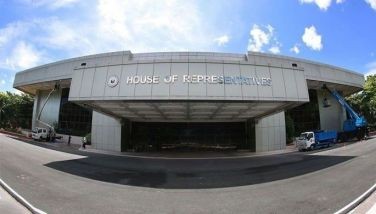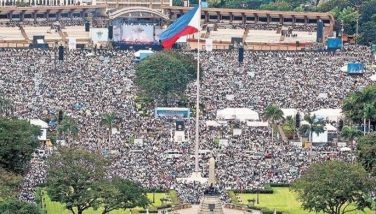British firm gives side on ‘bridges to nowhere’

January 12, 2006 | 12:00am
M&J SIDE: Comes now a representative of British firm Mabey & Johnson to give their side on the controversial "Bridges to Nowhere" that they have been building all over the country under the President’s bridges program.
The M&J man, actually a PR type, said in so many words that the British government was financing the steel spans through a loan, there is no overprice, the bridges are a boon to local transport and commerce, the beneficiary communities are happy, and that any insinuation of hanky-panky is wrong.
He showed me a bound collection of testimonials of satisfied local officials and another collection of color pictures of hundreds of bridges built in record time in the rural areas.
Later, he e-mailed me upon my request their "side" that I planned to print. To my disappointment, however, the literature sent looked like it was lifted from a tired background brochure of the bridges program.
Since I do not want to just pass on a brochure, I’ll pick up portions that, in my judgment, may be more relevant and interesting to readers waiting for answers to criticisms of the bridges program, its implementation and the people involved.
PROGRAM DETAILS: The M&J materials say: "The President’s Bridge Program (PBP) is a parallel intervention to fasttrack the provision of critical infrastructure development support aimed to address the country’s ballooning bridge requirement of about 15,000 or about 200,000 lineal meters of local and national bridges as reflected in the Medium-Term Philippine Development Plan.
"Annually, the Philippines has to deal with 22 to 27 typhoons or natural calamities destroying or weakening some 10,000 lineal meters of existing bridges. Even if foreign donor countries can supply an average of 20,000 lineal meters of bridges, there are still some 170,000 lineal meters of bridging required to be urgently constructed based on the 1994 NEDA approved master plan of bridges.
"The PBP aims to link the remotest and the poorest communities with the nation’s road network and highly urbanized centers creating an opportunity of spreading the fruits of economic progress to the greatest number of populace.
"In 1994, the UK government was trying to open up a bilateral cooperation between the Philippines and the UK. A UK ATP team came and assessed if the UK government can assist the Philippines through the provision of steel bridges in the rural areas to promote development. The bilateral cooperation arrangement was signed by no less than the Baroness Chalker. Based on the Aid and Trade Protocol (ATP) study, a Task Force on the President’s Bridge Program was created by President Ramos chaired by then Executive Secretary Guingona composed of six major line departments.
(The successive chairmen of the program from Executive Secretary Teofisto Guingona, through his successors, as well as their counterpart DPWH Secretaries are then listed.)
(Follows a tabulation of bridges completed under various presidents from Presidents Ramos [218 bridges], to Estrada [464], down to Arroyo [441] as of April 2005.)
"Like all foreign-assisted projects, all PBP projects pass through the NEDA-ICC process where the feasibilities and concessionality of financing of projects are assessed. The NEDA-ICC is composed of 12 major line departments of the government with three levels each of review and approval; technical committee; Cabinet committee; and the NEDA board.
"Upon NEDA board approval, the DoF negotiates the project’s financing which is approved by the Monetary Board. The contract is reviewed by the DoJ prior to contract signing. After the Philippine government processes, the contract is reviewed and declared effective by the UK government.
"The PBP selection process: (1) LGU identifies bridge requirements of the locality; (2) LGU submits bridge requirements through a resolution to the governor; (3) the governor endorses resolution to the Regional Development Councils; (4) RDC reviews and endorses bridge requirements to the PBP implementing agency; (5) each bridge is subjected to selection criteria established by the UKATP and the PBP; (6) bridges that passed the criteria are included in the agency Bridge Master Plan; (7) all bridges under a specific project are prioritized based on development thrust: (8) identified bridge requirements are endorsed by the chairman to the President for approval; (9) the approved and prioritized bridges are included in the project proposal for NEDA-ICC approval; and (10) Upon NEDA-ICC and UK government approval of the project, bridges are installed by the implementing agency.
"Time frame to install and complete a bridge: Unlike the reinforced concrete which takes years to complete or the massive steel trussed bridges which are difficult to transport and install in rugged rural areas, the PBP has distinguished itself to be a creator of wonder bridges given the completion time from one week to three months due to its bridging materials modular versatility.
"Monitoring the PBP: Projects are implemented by DPWH and funds are released directly to the agency through the Department of Budget and Management. The Department of Finance monitors and reports to the Monetary Board the utilization of the foreign and local component of the project. DPWH provides regular accomplishment reports to the President and NEDA. The UK bridge supplier Mabey & Johnson submits monthly reports to the UK Export Credit Guarantee Department.
"Implementation procedures: The LGU is responsible for constructing the road leading to the bridge. Mabey & Johnson supplies the bridging materials and the technical assistance. The implementing agency undertakes the installation and construction of approaches through competitive bidding done by the concerned LGUs as required under government prescribed rules and regulations. Oftentimes, the tertiary or barangay road appears to the urban onlooker as merely a trail.
"Flow of funding to PBP UK supplier: The M&J is directly paid by the UK bank as guaranteed by the UK government ECGD based on the RP-UK government contract provisions generally following strict international OECD procedures and regulations. Since February 2002, a more stringent process has been imposed by the UK government in view of its anti-terror law requiring all British companies to be subject to regular and random review of financial books.
(Follows a tabulation, unfortunately mixed up in transmission, of technical description and cost of steel bridges supplied by various firms aside from M&J. Other suppliers mentioned were Waagner Biro of Austria, JICA of Japan, and Balfour Betty of UK. It seems from the jumbled data that M&J wants to show that their bridges are cheaper.)
"As of 2005, the PBP (that part handled by M&J) has incurred cost underrun amounting to P1.2 billion, enabling it to build two flyovers (in San Fernando, Pampanga, and Malolos, Bulacan) and 150 more bridges without additional cost to the Philippine government.
(Now I know who built that rickety bridge across historic MacArthur Highway at its busy intersection with the Gapan-Olongapo road in San Fernando. I might not mind Lego-type temporary bridges being assembled in haste in rural villages, but to inflict a Bailey bridge on that major crossroads in the heart of Central Luzon is an insult to us. Drive over there and you will know what I mean. – fdp)
"Austrian Waagner Biro’s cost of P288,000 per lineal meter represents only the bridging materials and does not include the substructure and decks which are charged to the Philippine government, while Balfour Betty’s cost of P266,000 per lineal meter does not include the counterpart cost of the Philippine government and the 40-percent grant given by the British government for first-time UK suppliers under Organization of European Countries for Development (OECD) rules.
"M&J has designed and installed more than 13,000 bridges under PBP todate and not one of them has collapsed or showed any sign of cracked decks or deterioration. On the other hand, the Pasil bridge constructed by First Balfour Cleveland in Tabuk, Kalinga Apayao, collapsed on Feb. 8, 2004, a few weeks after being inaugurated. Hence it was reconstructed and was inaugurated again on April 22, 2004. Meanwhile, those of Waagner Biro have showed signs of cracked concrete decks raising fears of structural design instability."
ePOSTSCRIPT: You can read POSTSCRIPT at www.manilamail.com even before it sees print. Old columns dating as far back as five years ago can be accessed in the ManilaMail archive. Email comments to [email protected]. You can also use your cellphone. Type POSTSCRIPT, (space), followed by your name and message (not to exceed 149 characters), and send to 2960.
The M&J man, actually a PR type, said in so many words that the British government was financing the steel spans through a loan, there is no overprice, the bridges are a boon to local transport and commerce, the beneficiary communities are happy, and that any insinuation of hanky-panky is wrong.
He showed me a bound collection of testimonials of satisfied local officials and another collection of color pictures of hundreds of bridges built in record time in the rural areas.
Later, he e-mailed me upon my request their "side" that I planned to print. To my disappointment, however, the literature sent looked like it was lifted from a tired background brochure of the bridges program.
Since I do not want to just pass on a brochure, I’ll pick up portions that, in my judgment, may be more relevant and interesting to readers waiting for answers to criticisms of the bridges program, its implementation and the people involved.
"Annually, the Philippines has to deal with 22 to 27 typhoons or natural calamities destroying or weakening some 10,000 lineal meters of existing bridges. Even if foreign donor countries can supply an average of 20,000 lineal meters of bridges, there are still some 170,000 lineal meters of bridging required to be urgently constructed based on the 1994 NEDA approved master plan of bridges.
"The PBP aims to link the remotest and the poorest communities with the nation’s road network and highly urbanized centers creating an opportunity of spreading the fruits of economic progress to the greatest number of populace.
"In 1994, the UK government was trying to open up a bilateral cooperation between the Philippines and the UK. A UK ATP team came and assessed if the UK government can assist the Philippines through the provision of steel bridges in the rural areas to promote development. The bilateral cooperation arrangement was signed by no less than the Baroness Chalker. Based on the Aid and Trade Protocol (ATP) study, a Task Force on the President’s Bridge Program was created by President Ramos chaired by then Executive Secretary Guingona composed of six major line departments.
(The successive chairmen of the program from Executive Secretary Teofisto Guingona, through his successors, as well as their counterpart DPWH Secretaries are then listed.)
(Follows a tabulation of bridges completed under various presidents from Presidents Ramos [218 bridges], to Estrada [464], down to Arroyo [441] as of April 2005.)
"Like all foreign-assisted projects, all PBP projects pass through the NEDA-ICC process where the feasibilities and concessionality of financing of projects are assessed. The NEDA-ICC is composed of 12 major line departments of the government with three levels each of review and approval; technical committee; Cabinet committee; and the NEDA board.
"Upon NEDA board approval, the DoF negotiates the project’s financing which is approved by the Monetary Board. The contract is reviewed by the DoJ prior to contract signing. After the Philippine government processes, the contract is reviewed and declared effective by the UK government.
"The PBP selection process: (1) LGU identifies bridge requirements of the locality; (2) LGU submits bridge requirements through a resolution to the governor; (3) the governor endorses resolution to the Regional Development Councils; (4) RDC reviews and endorses bridge requirements to the PBP implementing agency; (5) each bridge is subjected to selection criteria established by the UKATP and the PBP; (6) bridges that passed the criteria are included in the agency Bridge Master Plan; (7) all bridges under a specific project are prioritized based on development thrust: (8) identified bridge requirements are endorsed by the chairman to the President for approval; (9) the approved and prioritized bridges are included in the project proposal for NEDA-ICC approval; and (10) Upon NEDA-ICC and UK government approval of the project, bridges are installed by the implementing agency.
"Time frame to install and complete a bridge: Unlike the reinforced concrete which takes years to complete or the massive steel trussed bridges which are difficult to transport and install in rugged rural areas, the PBP has distinguished itself to be a creator of wonder bridges given the completion time from one week to three months due to its bridging materials modular versatility.
"Monitoring the PBP: Projects are implemented by DPWH and funds are released directly to the agency through the Department of Budget and Management. The Department of Finance monitors and reports to the Monetary Board the utilization of the foreign and local component of the project. DPWH provides regular accomplishment reports to the President and NEDA. The UK bridge supplier Mabey & Johnson submits monthly reports to the UK Export Credit Guarantee Department.
"Implementation procedures: The LGU is responsible for constructing the road leading to the bridge. Mabey & Johnson supplies the bridging materials and the technical assistance. The implementing agency undertakes the installation and construction of approaches through competitive bidding done by the concerned LGUs as required under government prescribed rules and regulations. Oftentimes, the tertiary or barangay road appears to the urban onlooker as merely a trail.
"Flow of funding to PBP UK supplier: The M&J is directly paid by the UK bank as guaranteed by the UK government ECGD based on the RP-UK government contract provisions generally following strict international OECD procedures and regulations. Since February 2002, a more stringent process has been imposed by the UK government in view of its anti-terror law requiring all British companies to be subject to regular and random review of financial books.
(Follows a tabulation, unfortunately mixed up in transmission, of technical description and cost of steel bridges supplied by various firms aside from M&J. Other suppliers mentioned were Waagner Biro of Austria, JICA of Japan, and Balfour Betty of UK. It seems from the jumbled data that M&J wants to show that their bridges are cheaper.)
"As of 2005, the PBP (that part handled by M&J) has incurred cost underrun amounting to P1.2 billion, enabling it to build two flyovers (in San Fernando, Pampanga, and Malolos, Bulacan) and 150 more bridges without additional cost to the Philippine government.
(Now I know who built that rickety bridge across historic MacArthur Highway at its busy intersection with the Gapan-Olongapo road in San Fernando. I might not mind Lego-type temporary bridges being assembled in haste in rural villages, but to inflict a Bailey bridge on that major crossroads in the heart of Central Luzon is an insult to us. Drive over there and you will know what I mean. – fdp)
"Austrian Waagner Biro’s cost of P288,000 per lineal meter represents only the bridging materials and does not include the substructure and decks which are charged to the Philippine government, while Balfour Betty’s cost of P266,000 per lineal meter does not include the counterpart cost of the Philippine government and the 40-percent grant given by the British government for first-time UK suppliers under Organization of European Countries for Development (OECD) rules.
"M&J has designed and installed more than 13,000 bridges under PBP todate and not one of them has collapsed or showed any sign of cracked decks or deterioration. On the other hand, the Pasil bridge constructed by First Balfour Cleveland in Tabuk, Kalinga Apayao, collapsed on Feb. 8, 2004, a few weeks after being inaugurated. Hence it was reconstructed and was inaugurated again on April 22, 2004. Meanwhile, those of Waagner Biro have showed signs of cracked concrete decks raising fears of structural design instability."
BrandSpace Articles
<
>
- Latest
- Trending
Trending
Latest




























